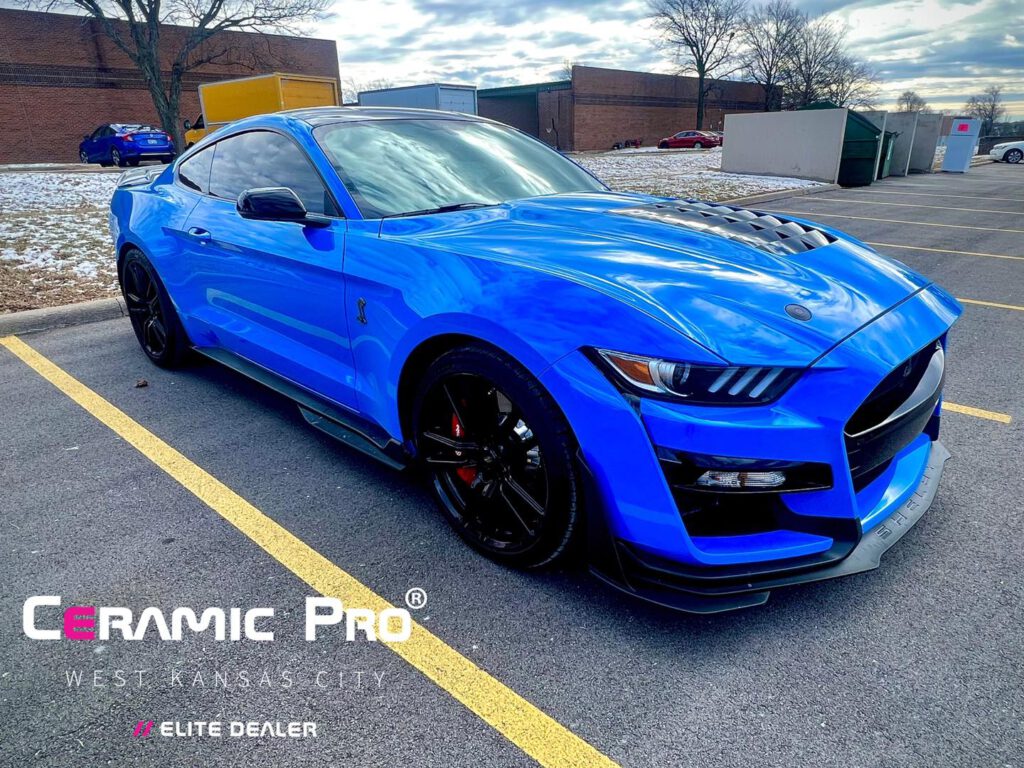
Keeping your car in pristine condition is a goal every car owner dreams of. You’ve probably heard about Paint Protection Film (PPF) and ceramic coatings, but which one should you choose? In 2024, the debate between PPF vs Ceramics for vehicle protection has become way more complicated than needed. Both PPF and ceramic coatings offer excellent protection for your car’s paint, but they have some key differences that you should consider before deciding.
When money is tight, and political uncertainty being top of mind, most vehicle owners in Kansas City become even more cautious about spending their money. However, if you buy a new car, truck, or SUV, and delay protecting it from road debris, you’re risking a lot of paint chip damage.
So – this brings us to our topic today, PPF vs Ceramics – which product is best for you to choose?
In this ultimate guide, we’ll break down everything you need to know about PPF vs ceramic coatings – specifically, which product is best suited for Kansas City roads and weather conditions.
When it comes to protecting your car’s paint, you have several options. Each has its own advantages, and the best choice depends on your needs and budget. And over the past 40 years, automotive paint protection products have made significant gains.
In the 1980’s – the protective product of choice was natural carnauba wax. This product was derived from a special palm tree located in South America and provided a few months of added shine and mild protection against UV rays.
As the 90’s and century turned, innovations in chemistry led to the formulation of spray-on waxes, with an infusion of Teflon – which is a ceramic ingredient. This enhanced the slickness of the coated surface, and introduced a buzz term that is often associated with modern coatings – hydrophobic.
As the 2000’s continued, innovations in nanotechnology created the first nanoceramic coatings, used primarily in commercial oceanic vessels. These formulations were fine-tuned for automotive clear coats, plastics, and textiles around 2010 – and hit US shores in 2013 as Ceramic Pro 9H.
This was also the same time that paint protection film became a popular vehicle protective product in the automotive sector. Initially, this film, once called helicopter tape, was developed by 3M for military applications during the Vietnam War.
In 2024, ceramics have morphed into a slew of confusing products, some are consumer-grade, and others are only installed by professional detailers. Modern PPF or clear bras have also improved, with several brands offering glossy or matte finishes, or even colored PPF – for the ultimate restyling and protection.
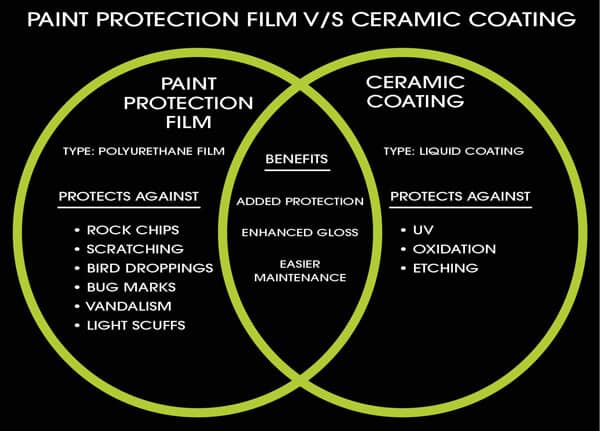
PPF or Clear Bra
PPF, also known as a clear bra, is a transparent film that adheres to your car’s paint. It offers a durable layer of protection against scratches, rock chips, and road debris. PPF is often used on luxury cars and newly purchased vehicles to maintain their showroom finish. This material is particularly popular among Porsche owners and those who prioritize long-term paint protection.
Ceramic Coatings
Ceramic coatings are liquid polymers applied to the exterior of a vehicle. They chemically bond with the car’s factory paint, creating a layer of protection. Unlike PPF, ceramic coatings don’t just sit on the surface; they integrate with the paint. This provides a high-gloss finish and can make washing your car easier by repelling water and dirt.
Vinyl Wraps
Vinyl wraps are another option for car protection and customization. While they don’t offer the same level of protection as PPF or ceramics, they allow you to change your car’s color or add unique designs. Vinyl wraps are a good choice for those looking to give their car a new look without committing to a permanent change.
Car Wax
Car wax has been a go-to for car enthusiasts for decades. It provides a temporary layer of protection and can enhance the shine of your vehicle. However, it doesn’t offer the same durability or level of protection as PPF or ceramic coatings. Wax needs to be reapplied regularly to maintain its effectiveness, making it less convenient for long-term protection.
Understanding the key differences between PPF and ceramic coatings can help you decide which is best for your vehicle.
PPF is a physical barrier that covers your car’s paint. It’s excellent at preventing physical damage from rocks, road debris, and minor scratches. On the other hand, ceramic coatings provide a chemical layer that bonds with the paint. This makes them effective at repelling water, dirt, and UV rays but less effective against physical impacts.
While both offer protection, PPF is generally more robust against physical damage, while ceramic coatings excel in providing a sleek, hydrophobic finish that makes maintenance easier.
PPF offers comprehensive protection against various environmental hazards.
Ceramic coatings offer a different type of protection, focusing more on environmental factors rather than physical damage.
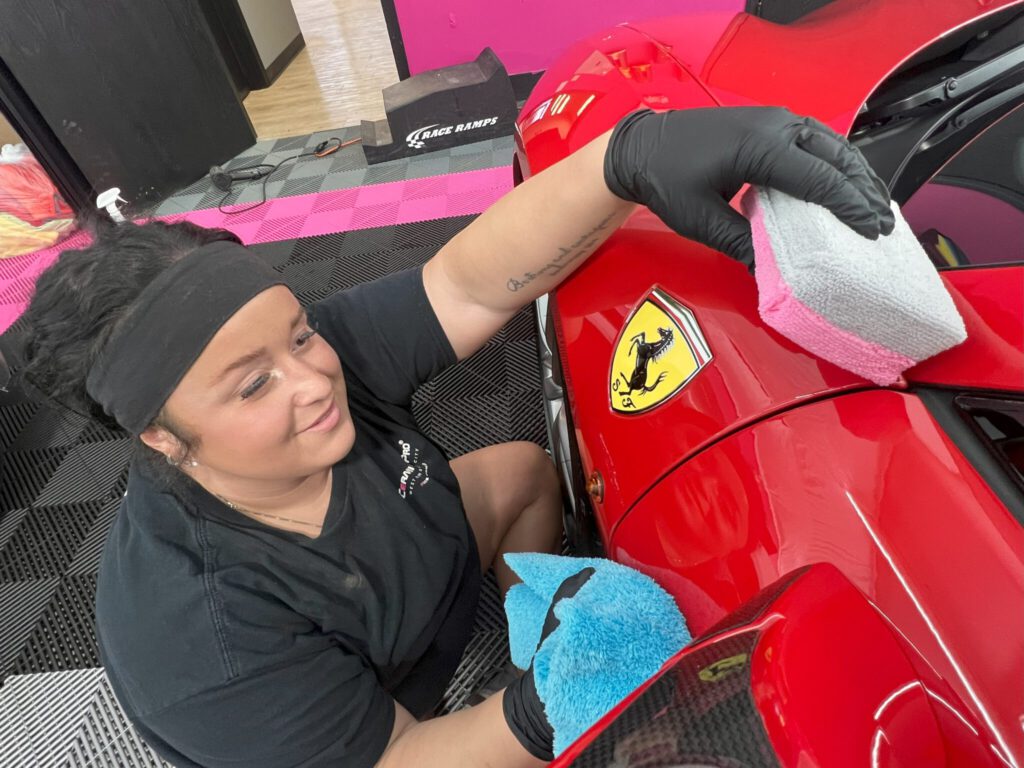
Modern ceramic coatings are applied via a microfiber applicator. The highly concentrated liquid coating is dripped on the applicator – then spread evenly across a small section.
The coating then fuses to microscopic imperfections found on clear coating, plastics, or other porous surfaces and cures. As it ‘flashes’ the residue is buffed away – or ‘leveled’.
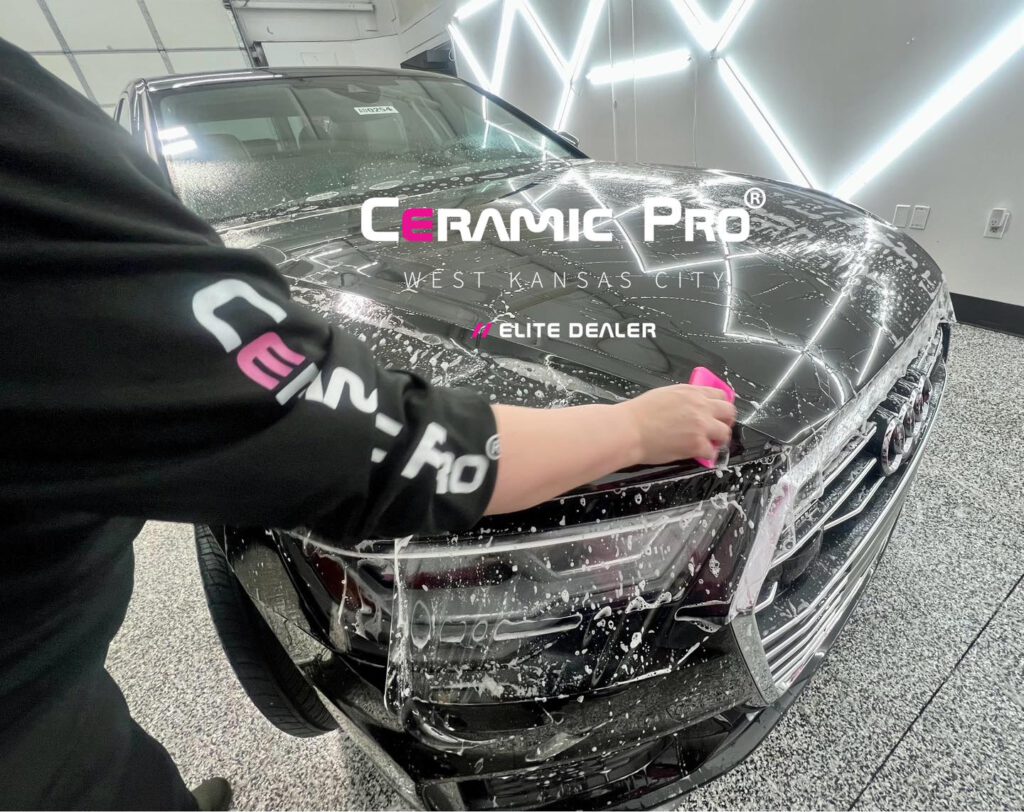
Paint protection film is computer cut, using a machine called a plotter, based on precise measurements for specific year, make, and models of vehicles.
The film is then hand installed, using a slip solution and precise stretching and installation techniques until it adheres to the painted surface. As the adhesive dries, the technician will precision tuck edges, so the installation is seamless and clean.
No product is perfect, and both PPF and ceramic coatings have their limitations. Understanding these limitations can help you make an informed decision about which option is best for your car.
PPF offers several advantages that make it a popular choice among car owners. These include:
While PPF has many benefits, it’s not without its downsides. These items are the primary objections that vehicle owners in Kansas City have regarding clear bra installation.
Ceramic coatings also come with their own set of advantages and disadvantages.
Pros:
Cons:
When considering return on investment (ROI), both PPF and ceramic coatings have their merits. PPF offers superior protection against physical damage, making it ideal for those who frequently drive on rough roads or highways. Ceramic coatings provide a high-gloss finish and ease of maintenance, which can be appealing for car enthusiasts who love a clean, shiny vehicle.
Ultimately, the best choice depends on your specific needs and budget. If physical protection is your priority, PPF will offer the best ROI. If you value a sleek finish and easier cleaning, ceramic coatings could be the way to go.
In summary, both PPF and ceramic coatings offer significant benefits for Kansas City car owners. By understanding the differences, advantages, and limitations of each, you can make an informed decision that best suits your vehicle’s needs.
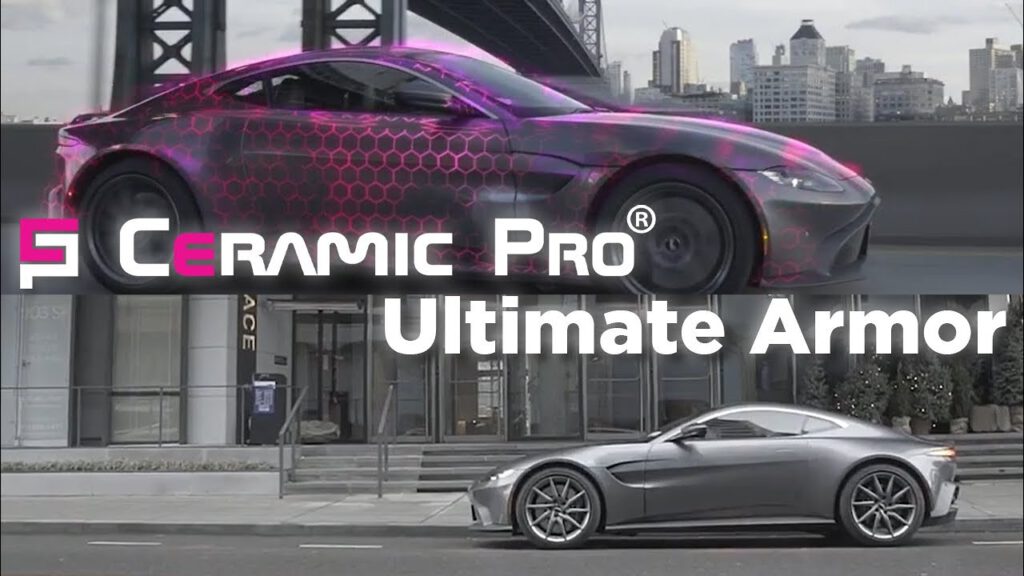
Of course, most clients of Ceramic Pro Elite West Kansas City opt for a combination of both PPF and ceramic coatings. This is represented in the Ultimate Armor package.
This exclusive offering – only available from Ceramic Pro Elite Dealers equips cars, trucks, and SUVs with a full front PPF installation and full vehicle ION ceramic coating. It’s the only full exterior package that is backed with a lifetime manufacturer warranty.
For those looking to explore more about these options, consider speaking with our team at Ceramic Pro Elite Kansas City. Our team will provide you with the facts about each product and recommend a package that makes sense.